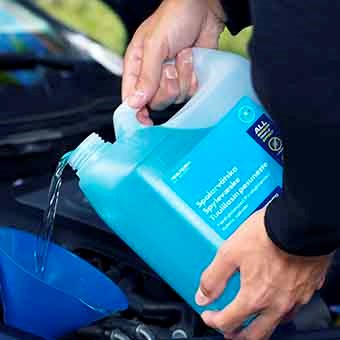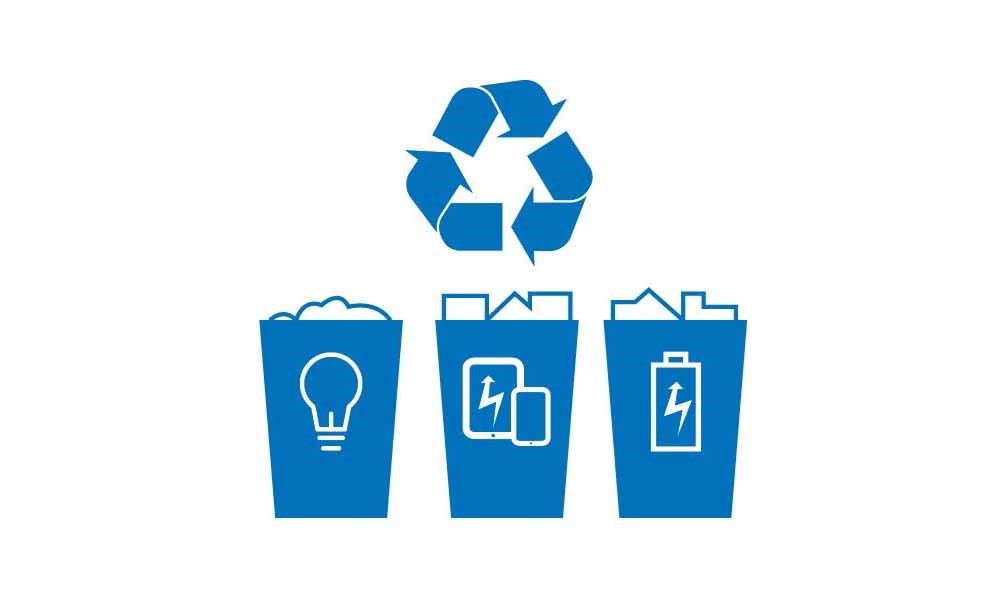Good to know about vehicle batteries
Different battery types for vehicles
In Biltema’s range there are three categories of rechargeable batteries. Although they may look similar from the outside, their internal structure and properties are very different.
Starter batteries
Starter batteries are used when starting fuel engines that require a large amount of power for a short period of time. Starter batteries are less suitable for operating other equipment. Starter batteries are available in SMF, Gel, AGM, Lithium and EFB models:
- SMF
Maintenance-free normal battery with liquid electrolyte in a sealed housing with overpressure safety valve. For vertical installation. - Gel
Maintenance-free battery where the electrolyte is bound in gel. Does not have a safety valve and can therefore be installed both horizontally and vertically. - AGM
Maintenance-free battery where the electrolyte is bound in an absorbent glass mat. This battery type can cope with more charges and discharges than a normal battery, and is therefore particularly suitable for cars with Start/Stop technology or which are started frequently. Can be installed horizontally or vertically. - Lithium
Maintenance-free battery with higher capacity, lower self-discharge and lower weight than acid batteries of equivalent size. Can be installed horizontally or vertically. - EFB
Maintenance-free battery with liquid electrolyte in a sealed housing with overpressure safety valve. This type of battery has twice the cycling resistance of a standard SMF battery. EFB batteries are specially designed for vehicles with Start/Stop systems. For vertical installation.
Leisure batteries
Leisure batteries are designed to power electrical equipment, and are therefore unsuitable as a starter battery. Available in SMF version.
Lead-acid batteries
Lead-acid batteries are used in larger toys or as a backup battery in various systems. Fully sealed battery that can be mounted horizontally or vertically.
Which vehicle battery should I choose?
In addition to batteries being manufactured for different purposes, they also vary in size, design and capacity depending on where they will be used. The electrical volume of a battery is specified in ampere hours (Ah), and for starter batteries where the capacity of the starting current is important, it is specified in Cold Cranking Amps (CCA).
For passenger cars and trucks
There may be several battery options for the same vehicle model depending on its equipment. The alternator and battery have been dimensioned together accordingly. Therefore, it is important to maintain the balance between alternator and battery when buying a new battery for your car. A good rule is to choose a battery with the same physical design, ampere hours, and starting current capacity as the old one. For example, there is no benefit in choosing a battery with significantly higher ampere hours, since it will take longer for your alternator to recharge and you may experience starting problems in cold weather.
For motorhomes and caravans
If your motorhome is equipped with a single battery, choose a starter battery or a motorhome battery. However, if it is equipped with several batteries, choose a starter battery for engine starting and one or more leisure batteries for equipment in the housing section. For caravans, leisure batteries with properties that comply with the manufacturer’s recommendations must be used. If the caravan is equipped with solar or wind power charging, use special batteries that can cope with such a low charging current without being damaged.
For motorcycles
On a motorcycle, battery space is often severely limited. Therefore, choose a battery with dimensions and capacity that are consistent with the manufacturer’s recommendations. If the battery is installed horizontally, you can choose a Gel or lithium battery. If the battery is installed vertically, you can choose an SMF.
For boats
In smaller boats with only one battery, use a starter or marine battery. For larger boats with multiple batteries, use a starter battery for the engine and leisure batteries for the other equipment. If the boat is equipped with charging from solar cells or wind power, the leisure batteries must be of a type suitable for this. If your boat has a bow thruster, it is better for it to be powered by its own AGM battery. For your safety, a boat with multiple batteries must be equipped with an isolator relay that ensures that the starter battery is always fully charged.
Installing and connecting your battery
Insert and anchor the battery securely in the vehicle’s battery holder, or in a dedicated battery compartment. In a motorhome, caravan, or boat, the battery compartment must be well ventilated and separated from other electrical equipment. However, it does not need to be drained as maintenance-free batteries normally do not emit any liquid. Before connecting the battery, it is important to first clean the terminals and cable lugs - connections with rust or verdigris can reduce the battery power by up to 25%. Polish the contact surfaces until shiny with a polishing brush or emery cloth and then lubricate with battery pole grease.
How to use and care for your battery
The normal service life of a rechargeable battery is around 4-5 years, but if you maintain it correctly, you can greatly extend the service life. Batteries function best when worked regularly – a battery that rests for a long time will stop functioning. Batteries should also not be allowed to deep discharged (below 12 V) as this causes oxidation of the electrical plates, which greatly impairs the battery life and capacity.
The battery bank on a boat or caravan should be supplemented with a battery protector that cuts the power to equipment before the voltage becomes too low. Batteries that are not used for more than five weeks, such as boat, motorcycle, or caravan batteries, must be stored in a cool, but frost-free area, and recharged once a month. It is advantageous to use a maintenance charger that continuously monitors and maintenance charges the battery.
- A fully charged battery has a rest voltage of about 12.7 V.
- A semi-charged battery has a rest voltage of about 12.2 V.
- A discharged battery has a rest voltage of about 11.7 V.
Charging your battery
Charge the battery on a durable surface in a well-ventilated area. Modern batteries are normally sealed, but if the battery is damaged or if an incorrectly set, incompatible, or broken charger is used, the battery may overheat and release hydrogen gas through the safety valve. Hydrogen gas, together with the ambient air, forms a very explosive gas. Therefore, when charging batteries, never use any other electrical equipment in the same room/area. When it comes to choosing a charger, there are battery boosters, traditional chargers, and intelligent chargers (lithium batteries require their own type of charger).
Battery boosters
A battery booster is a powerful quick-charger for one or more batteries. This charger type is used for emergency charging in workshops and is not suitable for normal charging as quick-charging wears heavily on the battery. A battery booster can be used for SMF and AGM batteries.
Traditional chargers
A traditional charger can be used for SME and AGM batteries but not Gel batteries. It’s cheaper and slightly faster than an intelligent charger, but you need to manually stop charging when the battery is fully charged or damage can occur.
Intelligent chargers
An intelligent charger can be used for SMF, AGM and Gel batteries. It adapts the charging current to the battery and automatically stops charging when the battery is full. The charger can also be used for maintenance charging of seasonal batteries.
No matter what type of charger you choose, it should correspond to the number of ampere hours on your battery. The battery capacity is specified in the product text for each battery charger.
Vehicle battery FAQs
What are ampere hours (Ah)?
Ampere hours (Ah) indicate the amount of current (capacity) a battery can transfer. For starter batteries, the capacity is measured during a 20 hour discharge at 25 °C to the final voltage of 10.5 V.
What does CCA mean?
CCA stands for Cold Cranking Amps. It is a measure of the current a fully charged, cooled battery can provide at -18 °C for at least 30 seconds before the battery reaches a low voltage of 7.2 V. When measuring brand-new batteries, the CCA value will often be about 20% below the specified value. Only after a few weeks of use has the battery been fully charged, after which the CCA value corresponds to that specified by the manufacturer. CCA is measured in several scales. Biltema has chosen to exclusively use the European Standard EN.
What is the correct charging voltage?
In a car, the charging voltage measured on the battery terminals should be approx. 14.4 V at 25 °C, and twice as high in 24 V systems, i.e. approx. 28.8 V.
When is a battery fully charged?
A fully charged battery maintains a resting voltage of 12.7 V. The acid weight is 1.28. A discharged battery has a resting voltage of 11.7 V. The acid weight is 1.20. If a battery is at a charge rate of 50% (12.4 V) or less for a prolonged period of time, the battery will begin to sulfate (see below) and be destroyed. It is important that a battery with a charge rate of 50% or less be recharged as soon as possible.
What does sulfation mean?
Sulfation is what happens when the battery rusts. The risk of sulfation increases the more discharged a battery becomes. The only way to avoid sulfation is to charge the battery regularly. This will give the battery a longer service life. When the battery is discharged, the lead and lead-oxide previously present on the battery’s lead plates turn into lead sulfate. This lead sulfate in turn forms water that dilutes the battery acid. The formation of lead sulfate is a natural part of the process in a battery. When the battery is recharged, the sulfate is regenerated into lead, lead-oxide and sulfuric acid. If the battery is left depleted, the lead sulfate crystals grow so much that they cannot be regenerated when charging. Sulfation has then occurred and the battery is usually destroyed.
Why does the battery get hot when charging?
One probable reason why the battery gets hot is that the battery has been discharged and thus partially sulfated. If the battery does not function after charging, replace it.
What happens if you connect a battery with the polarity reversed?
There will be immediate damage to the electrical system as the diodes in the alternator will be destroyed. Therefore, be extremely careful when inserting the battery since the damage caused by reversed polarity is often very costly to fix.
Can a battery explode?
For batteries to explode, there must be an external influence that ignites the hydrogen gas present in the battery. An explosion can occur if the battery has generally been charged but not adequately ventilated before the charger is removed. Static electricity is a common cause of hydrogen ignition. Be careful with puffer jackets and synthetic materials – especially in dry winter air. Turn off the charger and preferably wait a few minutes before disconnecting the charger’s battery terminal clips.
The battery has swelled or cracked, why?
Reason 1: The battery has discharged and therefore been able to freeze. The liquid in the battery has expanded and cracked the sides. A fully charged battery only begins to freeze at -67 °C, while a discharged battery freezes from -5 °C.
Reason 2: The battery has probably discharged and sulfated. The sulfur in the battery acid is then stuck to the plates. When charging the battery, the sulfur has nowhere to go except up towards the sides.
Reason 3: The battery has been overcharged. The heat makes the sides of the battery hot and the plastic gives way.



